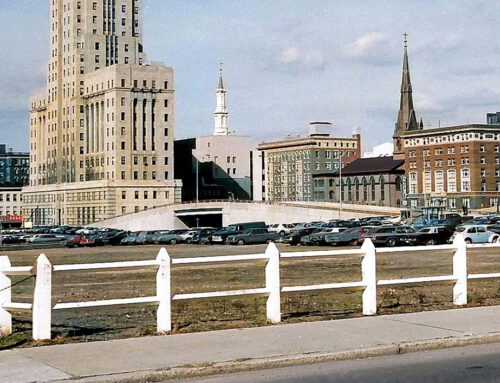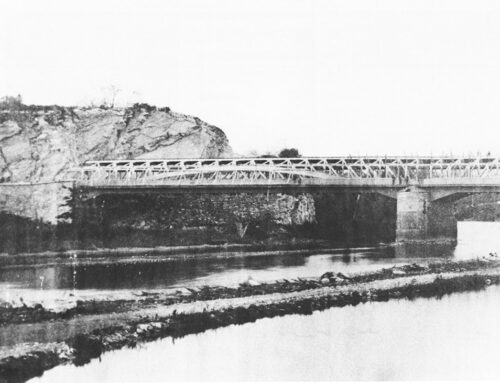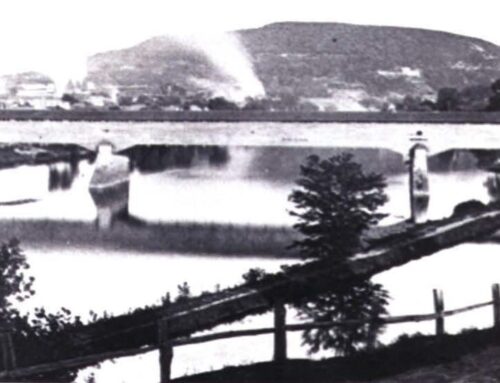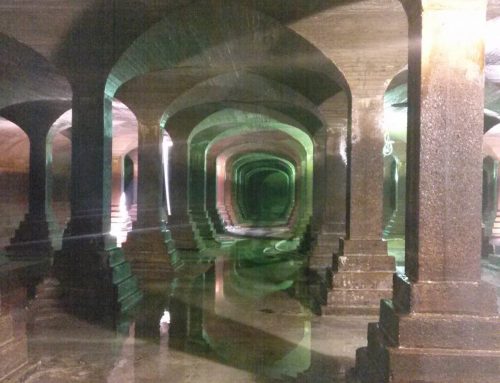Warren Street was constructed around 1920, running from Fayette Street near the Tulpehocken Creek east to a dead end near the Schuylkill River.
In 1949, plans were made to build a four-lane bridge across Tulpehocken Creek at Warren Street. As part of this plan, nine blocks of Warren Street, from its dead end at the Tulpehocken Creek to Schuylkill Avenue, were to be widened to 80 feet from the proposed bridge to Schuylkill Avenue. This widened Warren Street was envisioned to become part of a bypass route of Reading for US 222.
The bridge and widening was approved with the provision that Warren Street only be widened as far as Schuylkill Avenue as not to build a bypass route through a residential area. Glenside property owners didn’t want the same experience that befell Mineral Spring Road, which was a highly-desirable residential area before it was opened to heavy traffic.
Despite opposition construction on the bridge and the Warren Street Bypass between US 422 (Harrisburg Pike, now Penn Avenue) and PA 83 (now PA 183, Schuylkill Avenue) began in 1950. The first step toward the construction of the by-pass was taken when core drilling operations started on the west bank of the Tulpehocken Creek.
In 1953, the Park Avenue Extension (which extended Park Avenue in Wyomissing to the bypass) and the Warren Street Bypass from US 422 in Wyomissing to Tulpehocken Creek, along with the Tulpehocken Creek bridge, were finished, with a continuation of the Warren Street Bypass northeast from PA 183 to US 222 (Allentown Pike, now 5th Street Highway) proposed.
Construction on the extension of the Warren Street Bypass to US 222 began on February 14, 1956 with the process of widening of the existing Warren Street by the addition of two lanes. The PA 183 bridge over the bypass was built in 1957. In 1959, the Warren Street Bypass extension to US 222 was opened to traffic with the portion of Warren Street between Tulpehocken Creek and PA 183 widened to four lanes.
Below: Warren Street Bypass extension to US 222.

Below: The Warren Street Bypass included an interchange with the under-construction Reading Bypass (now US 422, West Shore Bypass) southwest of Tulpehocken Creek when it opened in 1959.

With increased development in the late 20th century a number of construction projects took place, most notably a four-lane Reading bypass, and a four-lane expressway to connect Lancaster to Reading.
Plans for linking the Warren Street Bypass to the north of Reading with the Philadelphia Pike east of Mount Penn began in 1956. The projected super-road was depicted as a substantial contribution to the economic welfare of central Berks County, not to mention its role as a vital element in resolving the multiplying problems of traffic congestion in the central business section of the city.
In 1958 the city received plans of the “West Shore Bypass.” The bypass, known officially as the “Reading Distribution Route” started at the Warren Street Bypass, south of the Tulpehocken Creek, and continued southeasterly, paralleling the Schuylkill River. The highway crossed the river and continued southeasterly just north of the Pennsylvania Railroad, then south of Forest Hills Memorial Park Cemetery to the Philadelphia Pike below Reiffton. Construction started later that year.
On August 6, 1965 one of Berks County’s most extensive and expensive highway projects – the West Shore Bypass of Reading – went into the official books with the switching on of 276 lights.
A report urging for a bridge in south Reading was not exactly received with opened arms. A South 9th street approach that would, upgrade South 9th street from Franklin to South street; construct a new facility from the base of 9th street,, to the West Shore Bypass with the route to remain on the east side of the Schuylkill River with no bridge and an interchange with the West Shore Bypass received some favorable response from the commissioners but was never built.
Studies for a limited-access highway connecting Lancaster and Reading began in the early 1950s. In 1962, construction began on a four-lane highway between Spring Township and Bern Township that would eventually connect to US 222. After construction stopped, this stretch became known as “The Road to Nowhere.” In 1968 the road was expanded northward further toward Route 183 and on to Muhlenberg Township, making a connection to US 222.
Below: “Road to Nowhere,” 1962.

Below: Former terminus at Van Reed Road looking southwest. Traffic followed Van Reed Road for several miles to U.S. 422.

In 1966, plans were made to make the portion of the Warren Street Bypass through the Glenside neighborhood of Reading limited-access by eliminating at-grade intersections with local streets, resulting in the streets coming to a dead end at the bypass.
In 1973, the federal government approved the relocation of homes and businesses along the path of the proposed US 222 freeway between Lancaster and Reading. In July 1977, the final section of the 20-mile US 222 freeway between Lancaster and the Berks County border opened to traffic.
In 1973 work began on the Warren Street Bypass to replace the four-lane State Hill road bridge with a new structure to carry six lanes.
An extension of the Warren Street Bypass from US 222 to Pricetown Road was proposed in 1962. Two routes for the extension were proposed: one following a more southerly route as it does today and another following a more northerly route along Spring Valley Road, passing near the Bernhart Reservoir. The extension of the bypass was intended to provide access to a growing industrial park.
Below: Dotted lines show two routes for proposed extension between US 222 and Pricetown Road.

The more southerly route for the Warren Street Bypass extension between US 222 and Pricetown Road was selected by 1969. By 1976, US 222 was routed to bypass Reading, with the route following the Warren Street Bypass between US 422 in Wyomissing and Allentown Pike. Also in 1976, construction began on the extension of the Warren Street Bypass between US 222 and Pricetown Road. The portion of the Warren Street Bypass between Spring Valley Road and Pricetown Road was completed in July 1979 while the portion between 11th Street and Spring Valley Road was completed in December 1979. In 1980, the remainder of the Warren Street Bypass extension between US 222 and 11th Street was completed.
Below: Southerly route for Warren Street Bypass extension.

In 1995, construction began on the Park Road Corridor, on a four-lane, limited-access highway, to connect US 222/US 422 at the junction of the West Shore Bypass and Warren Street Bypass to the road formerly known as the Road to Nowhere or the Outer Bypass (SR 3055). A no-build and four build alternatives were evaluated with respect to impacts upon natural, socioeconomic and cultural resources.

Accident statistics from the Pennsylvania Department of Transportation for 1986 to 1989 in the vicinity of Park Road, Warren Street Bypass and the West Shore Bypass ramps showed a total of 140 accidents, including 3 fatalities and 6 major injuries for this area.
Below: Intersection at Park Road and the Warren Street Bypass looking towards the Inn at Reading with traffic turning right onto the Warren Street Bypass.


Alternative A, a new alignment extending between the Warren Street/West Shore Bypass Interchange and the terminus of the Outer Bypass, was considered to best meet the project need. This alternative provided an efficient regional missing link in the highway system, was consistent with planned and existing land use and provided an effective interface between existing and local and regional transportation facilities. In addition. Alternative A was identified by the public as the preferred alternative from results of four public meetings due to its reduction of regional traffic volumes on local access roadways and its avoidance of impacts to residential areas and community facilities.
Below: Alternative A build plan: The at-grade intersection between Park Road and the Warren Street Bypass was eliminated. The connection of the Warren Street Bypass to US 222 highlighted in red below never materialized.

Construction of the Park Road Corridor was completed in October 1998. As a result, US 222 was shifted to follow the Park Road Corridor and the Road to Nowhere to bypass the Reading area, replacing SR 3055 along the Road to Nowhere. The former alignment of US 222 that was bypassed became PA 12 along the Warren Street Bypass between US 222/US 422 and US 222 Bus. and a northern extension of US 222 Bus. along 5th Street Highway and Allentown Pike through Muhlenberg Township.
Discussion among Berks County planning officials to improve the corridor between Reading and Lancaster began in the 1950’s and first appeared on the Central Berks Planning Study as two separate projects – the extension of the Warren Street Bypass and the reconstruction of Route 222/Lancaster Pike – in 1958. The projects were subsequently included in the initial Reading Area Transportation Study Plan of 1972. However, funding fell short and the projects were postponed in the mid 1970’s; despite the purchase of several parcels of right-of-way and construction of a major interchange on Warren Street at US Route 422. The projects languished for the better part of the next decade, but they remained a top priority among county planners, legislators, business leaders and various community interests.
A Task Force of Berks County municipalities and businesses raised money to purchase critical rights-of-way in an effort to keep the projects moving. The purchases were funded in part by a commitment of $7.5 million from Berks County, as well as donations by private sector interests and four municipalities through which the project passes. These local funding efforts helped keep the projects moving forward during funding shortages at the state and federal level that occurred in the early-to-mid 1990’s.
Finally, in mid-1997, with construction funding identified, the Federal Highway Administration issued a favorable Record of Decision, clearing the way for the start of final design and the eventual construction of the new Route 222.
Below: Oct. 27, 1998 – State and local officials join others at a groundbreaking ceremony in Spring Township for construction of the Warren Street Bypass extension.

In 1998, construction began on the US 222 freeway bypass of Reading between PA 724 and US 422; this section of road opened in 2000. Construction began in 2001 on the US 222 freeway between Grings Hill Road and PA 724 while construction of the section between the Lancaster County border and Grings Hill Road started in 2003. In 2004, construction was completed on the section of the US 222 freeway between Grings Hill Road and PA 724. As a result, US 222 was shifted to follow the new freeway between Grings Hill Road and US 422 and run concurrent with US 422 on the Warren Street Bypass north to the interchange with the West Shore Bypass and PA 12. The former alignment of US 222 along Lancaster Avenue became a southern extension of US 222 Bus.
June 2006 marked the completion of U.S. Route 222 Expressway between Reading and Lancaster; marking the completion of the US 222 freeway between Lancaster and Reading.
A proposed highway, called the Antietam Parkway, would have taken drivers on a scenic route past Antietam Lake and over the shoulder of Mount Penn. The road would have connected to the bypass near Spring Valley Road. Plans called for a two-lane road, designed mostly for passenger vehicles, with a limited number of intersections. The idea was to relieve some congestion on city streets and other roads. If the road were constructed according to the original plan, it would now cut through commercial development in Exeter Township and land owned by the Exeter School District.

Construction of bridge across the Schuylkill River at the North Wyomissing Blvd. Exit of the West Shore Bypass was proposed in 2001. The bridge was a key component of the Schuylkill River Development Project part of a plan proposed by St Joseph Medical Center. The plan was scrapped after St. Joseph’s Hospital relocated to a new $150 million hospital and medical office building on a 40-acre site in Bern Township, in 2006.







Leave A Comment